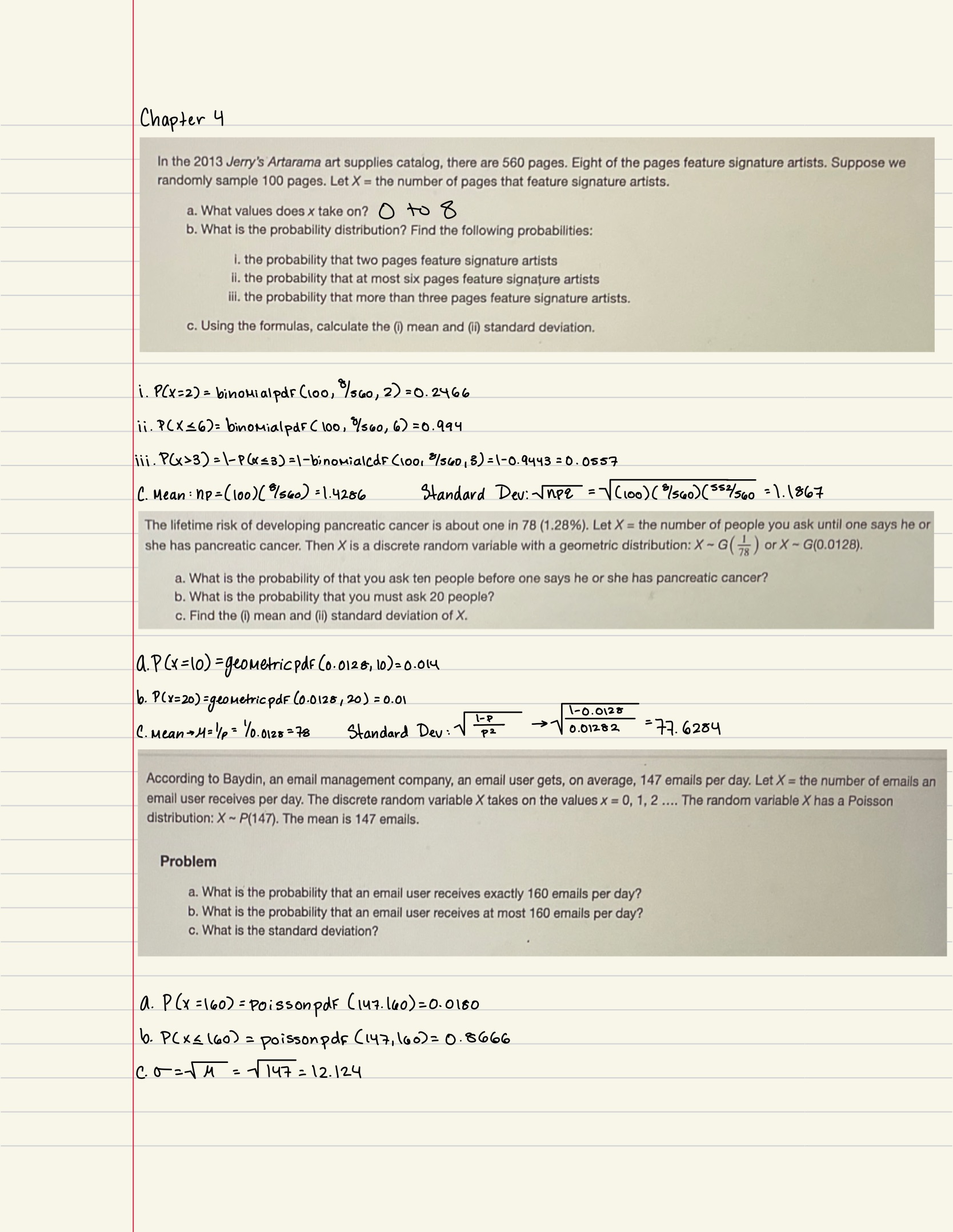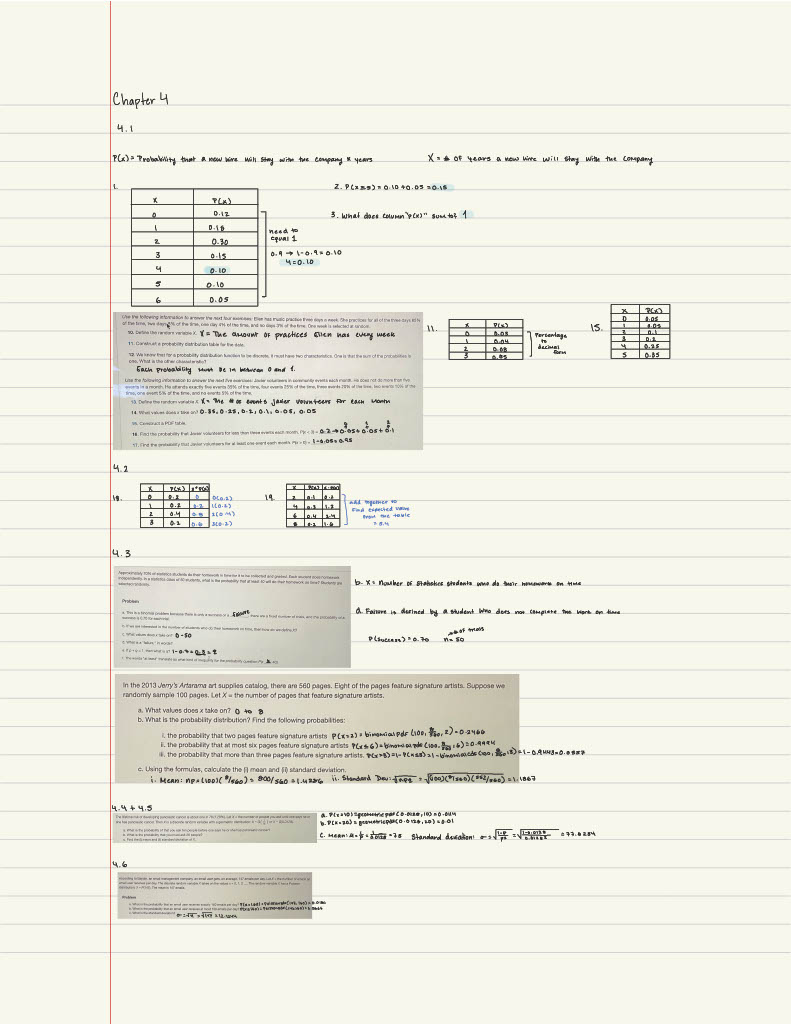
Chapter 4: Discrete Random Variables
Introduction
Random Variable Notation: Upper case letters such as X or Y denote a random variable. Lowercase letters like x or y denote the value of a random variable
4.1 Probability Distribution Function (PDF) for a Discrete Random Variable
A discrete probability distribution function has two characteristics:
Each probability is between zero and one, inclusive.
The sum of the probabilities is one.
4.2 Mean or Expected Value and Standard Deviation
Expected value: Referred to as the long-term average or mean. This means that over the long term of doing an experiment over and over, you would expect this average.
The Law of Large Numbers: as the number of trials in a probability experiment increases, the difference between the theoretical probability of an event and the relative frequency approaches zero


4.3 Binomial Distribution
3 Characteristics of a binomial experiment
There are a fixed number of trials
There are only 2 possible outcomes
The n trials are independent and are repeated using identical conditions

Binomial probability distribution:
Mean→μ = np
Variance→σ2 = npq
Standard deviation→ σ = √npq.
Bernoulli Trial: There are only two possible outcomes called “success” and “failure” for each trial. The probability p of a success is the same for any trial (so the probability q = 1 − p of a failure is the same for any trial).
Notation for the Binomial: B = Binomial Probability Distribution Function
X ~ B(n,p): Read this as "X is a random variable with a binomial distribution." The parameters are n and p; n = a number of trials, and p = probability of success on each trial.
Mean→μ = np
Standard deviation→σ = √npq
4.4 Geometric Distribution
3 Characteristics of a geometric experiment
There are one or more Bernoulli trials with all failures except the last one, which is a success. In other words, you keep repeating what you are doing until the first success.
In theory, the number of trials could go on forever. There must be at least one trial.
The probability, p, of a success and the probability, q, of a failure is the same for each trial. p + q = 1 and q = 1 − p.
X = the number of independent trials until the first success
Notation for the Geometric: G = Geometric Probability Distribution Function
X ~ G(p): Read this as "X is a random variable with a geometric distribution." The parameter is p; p = the probability of success for each trial.
Mean→μ = 1/p
Standard Deviation→σ = √1/𝑝(1/𝑝−1)
4.5 Hypergeometric Distribution
5 Characteristics of a hypergeometric experiment
You take samples from two groups.
You are concerned with a group of interest, called the first group.
You sample without replacement from the combined groups.
Each pick is not independent, since sampling is without replacement.
You are not dealing with Bernoulli Trials.
X = the number of items from the group of interest.
Notation for the Hypergeometric: H = Hypergeometric Probability Distribution Function
X ~ H(r, b, n): Read this as "X is a random variable with a hypergeometric distribution." The parameters are r, b, and n; r = the size of the group of interest (first group), b = the size of the second group, and n = the size of the chosen sample.
4.6 Poisson Distribution
2 Characteristics of a Poisson experiment
Gives the probability of a number of events occurring in a fixed interval of time or space if these events happen with a known average rate and independently of the time since the last event.
May be used to approximate the binomial if the probability of success is "small" (such as 0.01) and the number of trials is "large" (such as 1,000).
X = the number of occurrences in the interval of interest.
Notation for the Poisson: P = Poisson Probability Distribution Function
X ~ P(μ): Read this as "X is a random variable with a Poisson distribution." The parameter is μ (or λ); μ (or λ) = the mean for the interval of interest. The standard deviation of the Poisson distribution with mean µ is Σ=√μ
Example



Chapter 4: Discrete Random Variables
Introduction
Random Variable Notation: Upper case letters such as X or Y denote a random variable. Lowercase letters like x or y denote the value of a random variable
4.1 Probability Distribution Function (PDF) for a Discrete Random Variable
A discrete probability distribution function has two characteristics:
Each probability is between zero and one, inclusive.
The sum of the probabilities is one.
4.2 Mean or Expected Value and Standard Deviation
Expected value: Referred to as the long-term average or mean. This means that over the long term of doing an experiment over and over, you would expect this average.
The Law of Large Numbers: as the number of trials in a probability experiment increases, the difference between the theoretical probability of an event and the relative frequency approaches zero


4.3 Binomial Distribution
3 Characteristics of a binomial experiment
There are a fixed number of trials
There are only 2 possible outcomes
The n trials are independent and are repeated using identical conditions

Binomial probability distribution:
Mean→μ = np
Variance→σ2 = npq
Standard deviation→ σ = √npq.
Bernoulli Trial: There are only two possible outcomes called “success” and “failure” for each trial. The probability p of a success is the same for any trial (so the probability q = 1 − p of a failure is the same for any trial).
Notation for the Binomial: B = Binomial Probability Distribution Function
X ~ B(n,p): Read this as "X is a random variable with a binomial distribution." The parameters are n and p; n = a number of trials, and p = probability of success on each trial.
Mean→μ = np
Standard deviation→σ = √npq
4.4 Geometric Distribution
3 Characteristics of a geometric experiment
There are one or more Bernoulli trials with all failures except the last one, which is a success. In other words, you keep repeating what you are doing until the first success.
In theory, the number of trials could go on forever. There must be at least one trial.
The probability, p, of a success and the probability, q, of a failure is the same for each trial. p + q = 1 and q = 1 − p.
X = the number of independent trials until the first success
Notation for the Geometric: G = Geometric Probability Distribution Function
X ~ G(p): Read this as "X is a random variable with a geometric distribution." The parameter is p; p = the probability of success for each trial.
Mean→μ = 1/p
Standard Deviation→σ = √1/𝑝(1/𝑝−1)
4.5 Hypergeometric Distribution
5 Characteristics of a hypergeometric experiment
You take samples from two groups.
You are concerned with a group of interest, called the first group.
You sample without replacement from the combined groups.
Each pick is not independent, since sampling is without replacement.
You are not dealing with Bernoulli Trials.
X = the number of items from the group of interest.
Notation for the Hypergeometric: H = Hypergeometric Probability Distribution Function
X ~ H(r, b, n): Read this as "X is a random variable with a hypergeometric distribution." The parameters are r, b, and n; r = the size of the group of interest (first group), b = the size of the second group, and n = the size of the chosen sample.
4.6 Poisson Distribution
2 Characteristics of a Poisson experiment
Gives the probability of a number of events occurring in a fixed interval of time or space if these events happen with a known average rate and independently of the time since the last event.
May be used to approximate the binomial if the probability of success is "small" (such as 0.01) and the number of trials is "large" (such as 1,000).
X = the number of occurrences in the interval of interest.
Notation for the Poisson: P = Poisson Probability Distribution Function
X ~ P(μ): Read this as "X is a random variable with a Poisson distribution." The parameter is μ (or λ); μ (or λ) = the mean for the interval of interest. The standard deviation of the Poisson distribution with mean µ is Σ=√μ
Example



 Knowt
Knowt